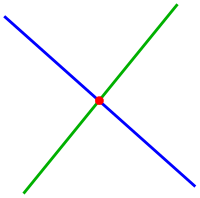Intersection
This article needs additional citations for verification. (January 2014) |



In
Intersection is one of the basic concepts of
Uniqueness[clarification needed]
There can be more than one primitive object, such as points (pictured above), that form an intersection. The intersection can be viewed collectively as all of the shared objects (i.e., the intersection operation results in a set, possibly empty), or as several intersection objects (possibly zero).
In set theory

The intersection of two sets A and B is the set of elements which are in both A and B. Formally,
- .[1]
For example, if and , then . A more elaborate example (involving infinite sets) is:
As another example, the number 5 is not contained in the intersection of the set of
In geometry

In
- Line–plane intersection
- Line–sphere intersection
- Intersection of a polyhedron with a line
- Line segment intersection
- Intersection curve
Notation
Intersection is denoted by the U+2229 ∩ INTERSECTION from
The symbol U+2229 ∩ INTERSECTION was first used by Hermann Grassmann in Die Ausdehnungslehre von 1844 as general operation symbol, not specialized for intersection. From there, it was used by Giuseppe Peano (1858–1932) for intersection, in 1888 in Calcolo geometrico secondo l'Ausdehnungslehre di H. Grassmann.[2][3]
Peano also created the large symbols for general intersection and union of more than two classes in his 1908 book Formulario mathematico.[4][5]
See also
- Constructive solid geometry, Boolean Intersection is one of the ways of combining 2D/3D shapes
- Dimensionally Extended 9-Intersection Model
- Meet (lattice theory)
- Intersection (set theory)
- Union (set theory)
References
- ISBN 9780821827314.
- Fratelli Bocca.
- ISBN 9781602067141.
- OCLC 23485397.
- ^ Earliest Uses of Symbols of Set Theory and Logic








